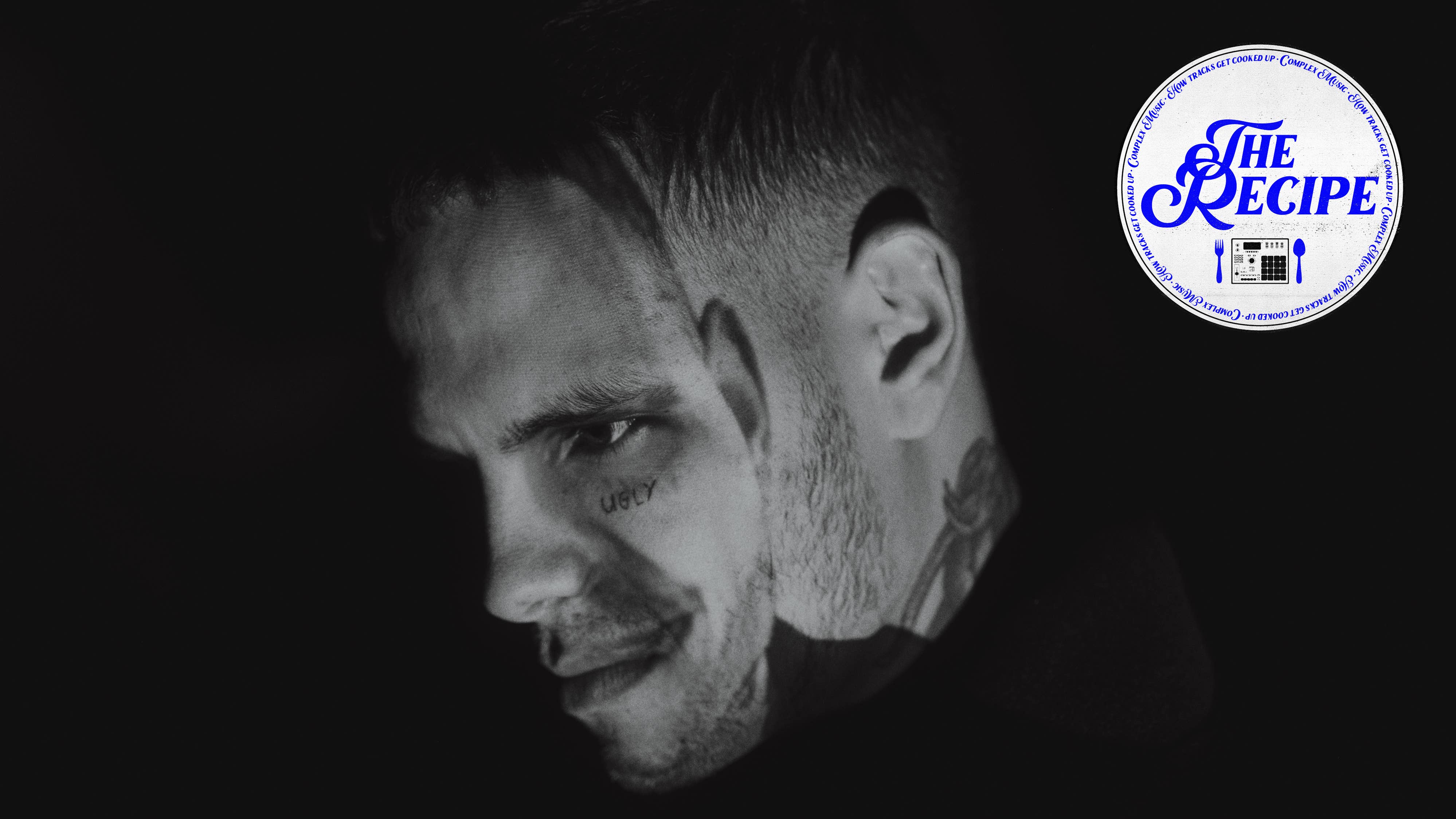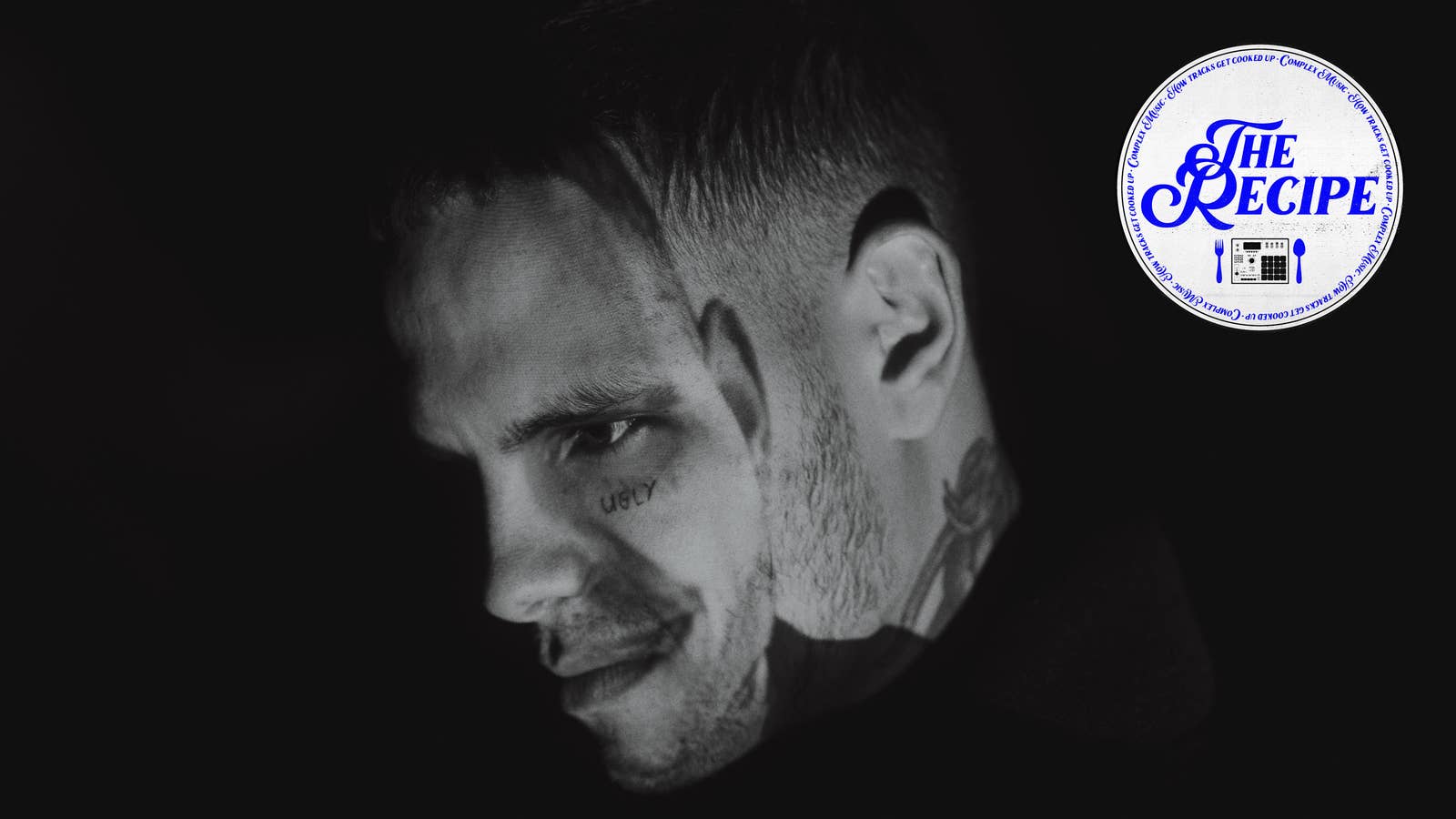
Welcome to The Recipe, a space where standout artists and their closest collaborators sit down with Complex to provide insight into their creative processes.
Production whirrs as if it’s recorded straight from a clangorous metal fan in an abandoned warehouse, before Tyron Frampton, more widely known as Slowthai, jumps in. His staccato spoken-word rap hits like a boxer hopping, pacing, ready to pounce. He breathes, loudly, through his teeth.
“You are great/You are good/You’re a king/ You’re a queen/You’re a genius,” he repeats; it’s a self-care mantra delivered as a threat. Modular synths build—like an industrial Nine Inch Nails track recorded in hell. Anxiety is heightened and Ty lets out an otherworldly scream. “Yum” is a hideous opening track, a truly magnificent feat that sounds like how it would feel to watch someone pump themselves up in a bathroom mirror and then bash their head directly into it, shattering the glass.
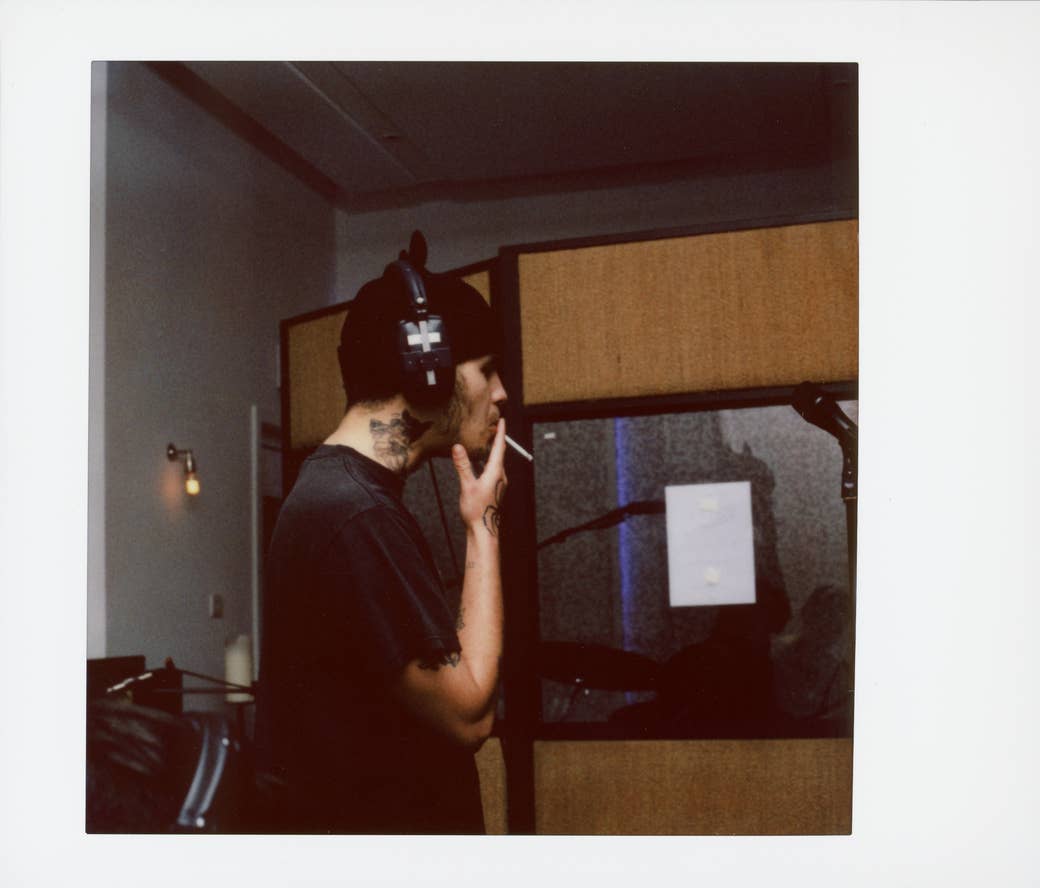
Day one fans of Slowthai have known him as the Northampton grime rapper with punk sensibilities and a mad smile, a unique combination of abrasion and sensitivity. On UGLY—which stands for “U Gotta Love Yourself”—they get to know him more profoundly as he touches on fatherhood, hedonism, mental health, and otherness.
Ty’s third album has no features, but tons of collaborations: it took a village to get to this place of freedom—a rapper that bounces around with genres, excavating sounds across ‘90s darkside rave, alt-rock, punk, post-punk, rap, and grime. For UGLY, over the course of the last two years, Ty and his manager/creative director/cousin Lewis Levi were joined by photographer George Muncey, a number of producers and writers, including Dan Carey (Kate Tempest, Fontaines D.C.) and longtime Slowthai collaborator Kwes Darko, to create the rapper’s most revealing and eccentric album yet.
“We started doing really heavy stuff, got a drummer in, made more punk-y stuff and drifted away from the electronic hip-hop thing,” says Dan Carey. “That happened quite gradually.” The majority of the album was recorded in Carey’s home studio, but a few of the tracks, like “Falling” and “Tourniquet,” were completed at Narcissus, a studio in London. Collaborators came in and out.
“We had guest vocalists as well, and in some sessions we had Beabadoobee. At one point, we had James Blake in on the sessions as well, just jamming,” Kwes Darko laughs. “We’ve got 10 hours of jamming with James Blake somewhere. He didn’t make the album.”
“It was a good time. It was the most fun I’ve probably had, and [the most] freedom. Without barriers, I was just exploring,” Ty tells Complex, with his idiosyncratic smile. “It kind of just made me love doing it again. [Music making] started feeling like a chore at one point. Now, I just can’t wait to make more music.”
“ I wanted to challenge people and challenge myself. When something becomes muscle memory, you should do something else.”
A lot has changed in his life since the release of his sophomore LP, Tyron, in 2021. The 28-year-old has gone to therapy and become a dad. The latter, perhaps his proudest moment; an appointment he refers to as him now being “responsible for a little perfect human being.” All of the aforementioned somehow unearthed the confidence to realize he could make whatever fluid music he wanted if he allowed himself the space for that boldness in experimentation.
“At this point in time, I wanted to challenge people and challenge myself. When something becomes muscle memory, you should do something else or you’re never going to improve and you’re never gonna get better,” he asserts. That’s evident across the LP, and especially so on the title track “UGLY”, with its sludgy post-punk live band recording, Slowthai’s swaggering singing and forceful rapping–the maudlin spelling of “U-G-L-Y” repeated with increasing absurdity.
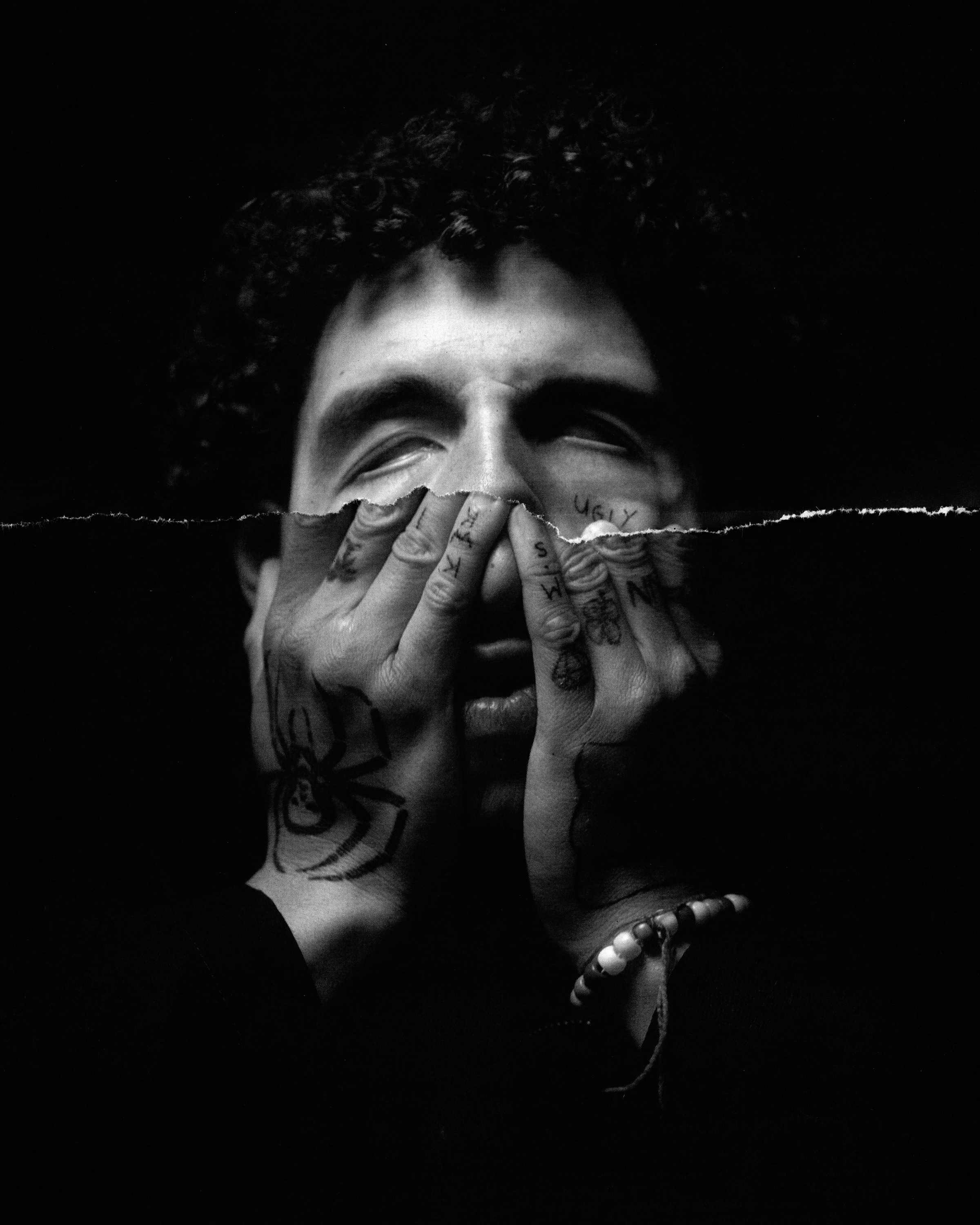
His hopes for listeners are simple. “I want to broaden horizons and open their eyes to different music,” he says of UGLY. “You got to love yourself and let people know they’re not alone—I want them to live with the album and grow with it. All of us have something ugly, so love yourself as is.”
Below, Ty and his closest collaborators break down the recipe behind his triumphant third LP, UGLY.
CHEFS IN THE KITCHEN
Slowthai will be the first to tell you: UGLY took an army with a shared vision. Below, we speak to some of Ty’s long-time collaborators (his manager/creative director Lewis Levi, trusted producer/right-hand-man Kwes Darko), new additions (rock producer Dan Carey, photographer/creative director George Muncey) as well as Slowthai himself.
Slowthai (Tyron Frampton) – Rapper
Dan Carey – Producer, Writer
Kwes Darko – Producer, Writer
Lewis Levi – Manager, Creative Director
George Muncey – Photographer, Creative Director
Zach Nahome – Producer, Writer
Ethan P. Flynn – Producer, Writer
Sega Bodega – Producer, Writer on “Feel Good”
Shygirl (Blane Muise) – Backing Vocals on “Feel Good”
Jacob Bugden (Beabadoobee) – Producer, Writer
Alexis Smith – Recording Engineer
Christian Wright – Mastering Engineer
Yuri Shibuichi – Drummer
Liam Toon – Drummer, Writer
Fontaines D.C. (Carlos O’Connell, Conor Curley, Conor Deegann III, Grian Chatten, Tom Coll) – Live band on “UGLY”
Oly Carey – Backing Vocals on “25% Club”
SLOWTHAI: Dan Carey and Kwes, they gassed me up. When you’re in the process of making music with other people, it’s a beautiful thing: the journey of it from the start to the finish and in between, the ups and downs. Obviously your life contributes to that. One day might come in and you’re extra hyperactive and the next day you’re overtired. Then the next day I’m super depressed. I don’t really want to be there. But then by the end of the day, man, I’m so thankful I was here… I’m so proud of everyone involved, but just proud of myself. And that’s a goal for me. I suppose I want to feel good.
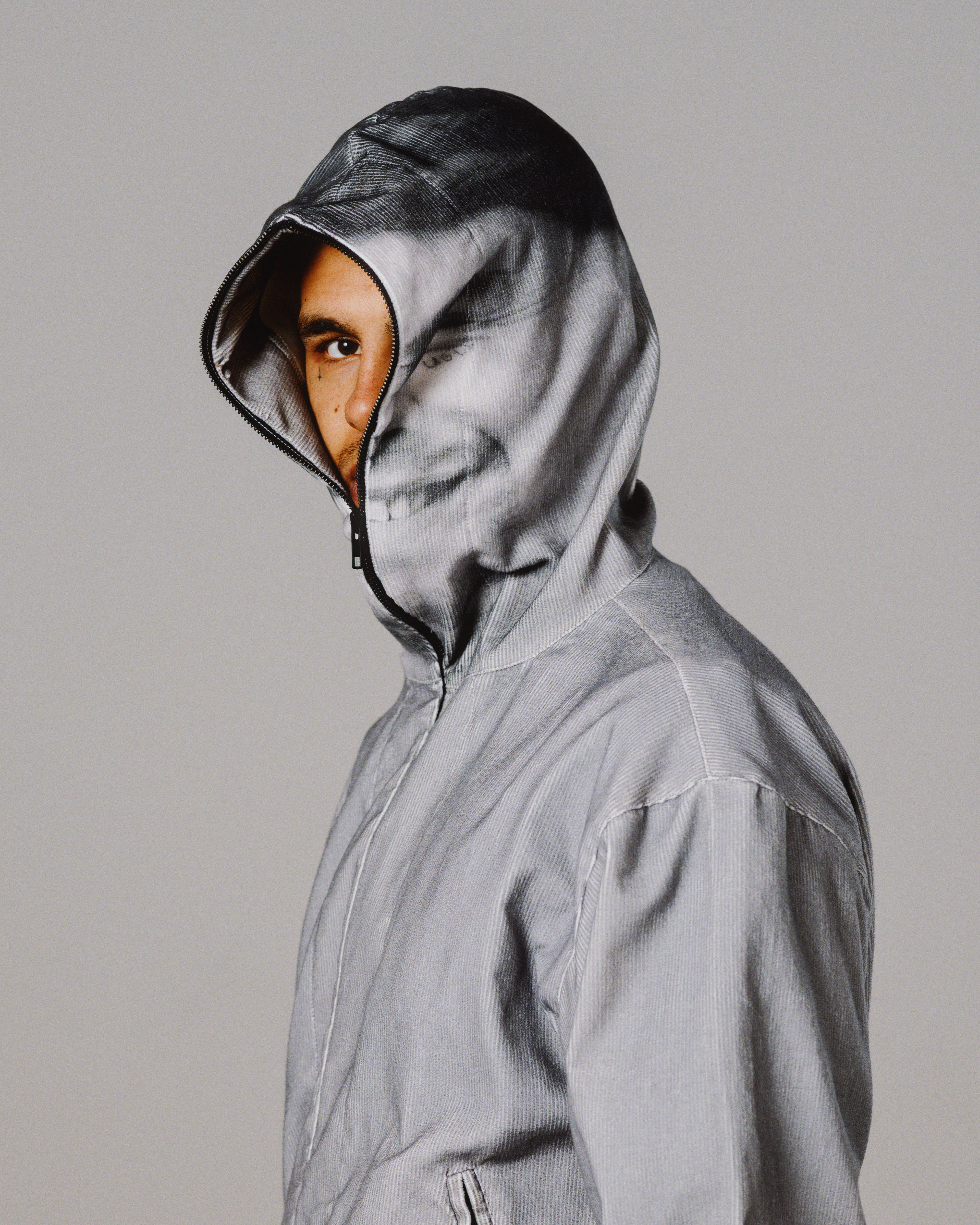
How they began working with Slowthai:
DAN CAREY: I’ve been a fan of Ty since the beginning. He’s amazing. I’d been keen to try and do something with him, but I didn’t really know how to approach getting around to that.I think it was Kate Tempest’s The Books of Traps and Lessons that got Ty’s attention. We had time planned [together] but it got canceled because he had a baby. His manager, Lewis, called and suggested I get together with Kwes Darko, and we just made beats, some starting points for a potential record. We had an amazing couple of days. He had never been to my studio before, and it’s rammed full of interesting stuff. He was like, “Show me what you’ve got.” We went around the studio, in a clockwise direction, just switching things on, making stuff.
I had done the Fontaines D.C. record; Kwes and I had made the backing track for “UGLY.” I was joking, I said, “Why don’t we get Fontaines to come in and play along with it and make it sound immense?” And Ty was like “Yeah!” I’ve done all their records, they’re good mates, so I had them come in. That’s where the other dimension of the record started to come in: more guitars, two live drummers—instead of programmed stuff, or a mixture of the two.
KWES DARKO: Dan was someone I had always admired from afar. When I met him, it was like I had just met the more experienced mind of mine. I was looking at his studio, I was like, “You’re me, with an extra 10 or 15 years of me in the game.” It’s rare for me to meet producers of a certain era that I connect to. Dan’s open to experiencing new things. There’s no, “No, it should go this way.” That’s how we’ve always created: naturally. And Dan understood that. And him understanding more band stuff, that’s the element we wanted to bring in. Ty wanted more guitars, live instrumentation, and Dan’s space [has] all that.
LEWIS LEVI: Me and Ty are cousins and I manage him. I’m the Creative Director. I’ve been a fan of George’s work for the last like, six, seven years. I started showing him the music and was like, “This is the direction.” With the music videos: We’re both part of a duo. I’m part of a duo called THE REST, where I’ve got a partner called Alex [Motlhabane]. And George is part of a duo called UNCANNY, in which he has a business partner called Elliot [Elder], and everyone played a vital part [in the visuals] but me and George were the ones that stayed communicating the whole time basically.
GEORGE MUNCEY: On paper, it’s mental. It’s crazy to have so many cooks in the kitchen. For me and Lewis to both have our own separate things but to work with this fluidity, that doesn’t feel like there’s a hierarchy… things just work.
LEWIS LEVI: The bones of the project are people who, at their core, are very much inspired by challenges and boundary-pushing, rather than ego. “How do we push it forward? What’s the best thing?” The music videos are art pieces, in a way.
KEY INGREDIENTS
Post-punk influences, self-reflective artwork, and constant jamming and experimentation–on rock band instruments (guitars, drums, bass, piano) as well as modular synths, MPCs, Swarmatrons and more–built the unique vision for UGLY.
On key instrumentation:
DAN CAREY: The thing about Ty is that he’s not afraid to go down a new route, to follow a spark of a new idea. Kwes would be on the Octatrack, Zach would be on the laptop, and I’d be on the studio computer. Zach would say, “Give me a minute,” and take the vocals and fuck around on the track and send it back to me. There was stuff flying around all the time. Ty would react to that and sometimes that would change how he was writing the lyrics.
KWES DARKO: Dan has this rare synth; I can’t even describe what kind it is—it’s crazy rare. That was used quite a lot on the album, amd this crazy modular set up. There were times where we were resampling Ty’s voice, resampling it and running it through. A lot of it is in the detail of the music—there are things in there that you don’t necessarily hear, but they make up the painting. They make the picture make sense.
DAN CAREY: In my studio, there’s this big modular thing called the Colossus. And it’s quite present on a lot of the record. Quite often, I’d run parts through that thing for consistency of sound. Sometimes just the demo vocal. Ty’s really interesting: Once he’s delivered a vocal, he doesn’t really like to do it again. He doesn’t see the value. We’re both of the opinion that if it’s there, you should just leave it.
Most of the beat programming was done on an MPC. That’s really key. The Swarmatron is something that I rely on; it’s part of my sound. Whatever I’m doing, I have the Swarmatron sitting there somewhere. A lot of the analogy stuff is tracked through the Neve presets and mixed through an analog desk. Sometimes we sectioned off parts we wanted to hit harder. The guitars and amps on “Wotz Funny,” “Happy,” and “UGLY” we set things up in one room, a live room instead of a control room situation. Everything’s in the middle room for a big punchy sound, with lots of room mics. And the big modular synth setup tends to come to the fore and favored. My daughter is the female vocal on [“25% Club”]. She’s a massive fan. More than anything I’ve ever worked on.
What was playing in the background:
KWES DARKO: Ty’s into Daniel Johnston, Patti Smith… There were a few [alt-rock musical inspirations we were listening to]. But we also tried not to indulge into too much music. We’re not trying to re-create anything. I grew up around band music and rap and electronic music, Ty’s the same thing. We had pre-influences before the album. “Hey” by the Pixies is one of my favorite songs ever made.
SLOWTHAI: I was mainly listening to what we were doing: We’d make stuff, then I’d spin that the next day or so to see what we could do differently. But before that, it was a lot of the Pixies, the Verve, the Strokes, Joy Division—everyone that was so ahead of their time with what they were doing. Some days it would be Moby. I was listening to Muse and Radiohead, only because I love Thom Yorke’s tone. And Matthew Bellamy’s got quite a similar drone, so maybe I was influenced by them. I feel like I was more influenced by myself.
The meaning behind the artwork:
LEWIS LEVI: There are three different artworks. The blurry one is the back cover but there’s another one, the indie exclusives, where it’s like behind his head and he’s got his face down and you can see a big scar on his face. It’s less to do with “he looks UGLY.” It’s more, like, this is how the world makes him feel. The [closeup of the] eye for the front cover is because the album is so up close and personal, you feel like he’s right in your ear [through] all the whispering and shouts. That’s why it starts close.
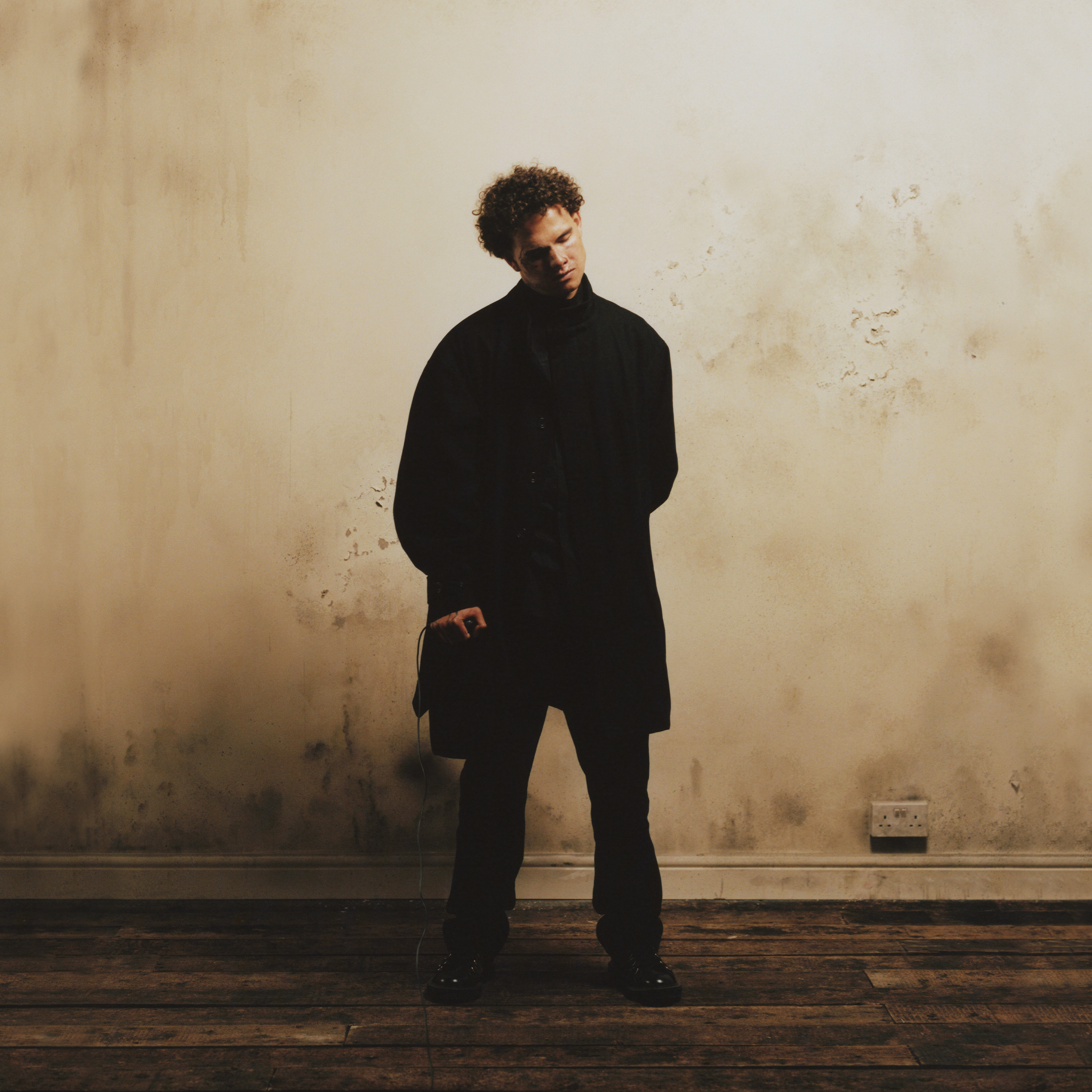
GEORGE MUNCEY: A big thing with all the imagery was to make it intimate, raw, and personal. In the widest shot, the full body image, Ty actually takes the photo himself. I gave him a self-release cable. So, when he felt that he was ready, we got him to take the photo. It’s a little sphere that blows a puff of air that triggers the camera. There was a big desire to lean into a stripped back look, as opposed to maybe something in the past, which has been charismatic and very loud. [This is] a complete 180…
For the self-shot photos, there’s a series of photos called Ghetto by Broomberg & Chanarin, which is a photographic duo. And they went to seven ghettos across the globe and did this kind of documentary photo series throughout them. At the end, they got the patients in the asylums to take their own photos with a self-shutter. That was one of the things which was driving me towards that idea.
TABLE SETUP
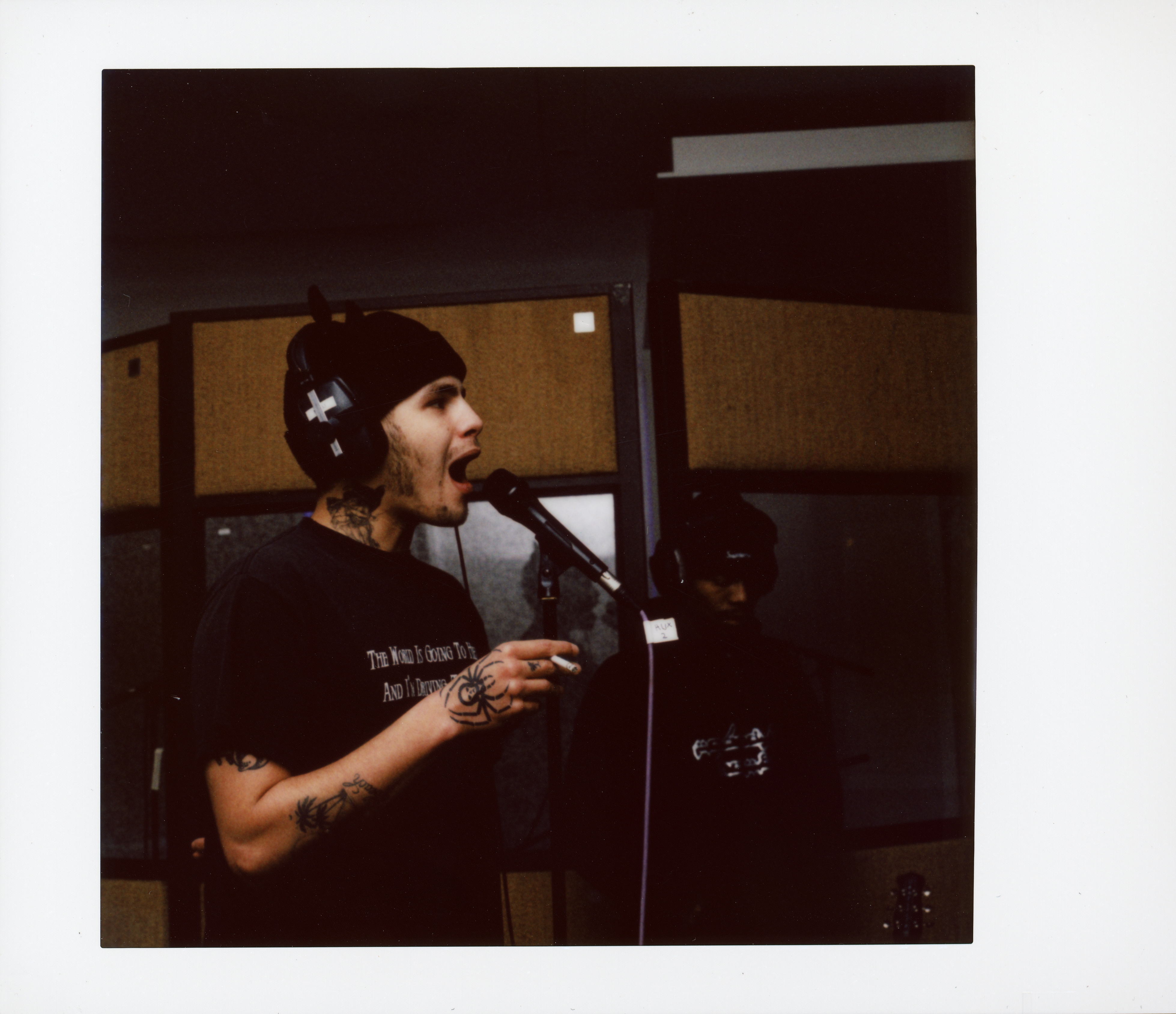
Slowthai and his team value welcoming studios–places where play is promoted, and ideas are explored–if you demand a song sound a certain way, you’re out. If the space feels like it’s meant for productivity and productivity alone, it was out.
KWES DARKO: There was a mix between studios. A lot of the ideas were actually created in a studio called Narcissus in Northwest London, Wilson. That’s a studio that is just close to our hearts. It feels like home. It’s a playground for us—that’s how I like my studios: you’re gonna walk into a space where it doesn’t look like you’re going to work. You’re walking into a space like your friend’s bedroom, kind of thing. It’s got toys that you can just play [with] in the studio. And Narcissus Studio has that vibe, which made it so much easier to go in there and jam. We’ve got jams from Narcissus for four, five hours, just playing live with a whole band and we’d create from that. So, Narcissus is really where the bed was created. Then we moved onto finalize everything: re-recording drums, retrack drums, retrack guitars, bass… synths, all that was done at Dan’s home studio, which is amazing.
THE RECIPE
The message behind UGLY–“U Gotta Love Yourself”–drove the punk-y exorcism that became the album: from YouTube-influenced music visualizers, wild days in the studio, and mind-blowing detours.
Landing on the album’s name:
SLOWTHAI: I had Wotz Funny first, and then it became UGLY. I always knew I wanted to make an album called UGLY. I wanted a band called “UGLY.” When the acronym came to me, “U Gotta Love Yourself,” I was like, “That’s the title.” At a point in time, my outlook, and the way I felt about myself was “UGLY.” Shebang! That’s the one right there.
KWES DARKO: I was thinking about the Joker, a mad way of thinking—a weird, bizarre vision—and seeing how we could connect those two dots. Ty, to us, he is the Joker. He’s got that energy to him.
The first track they made:
KWES DARKO: The first track that was made on the album was “Selfish,” that was me and Ty. He had a setup in Northampton for a bit and he was just messing around and “Selfish” just came about. He had just had his baby, he got away for just a few hours to go to the studio, and we ended up at “Selfish.”
DAN CAREY: When [Kwes] first gave “Selfish” to me, he was like, “This one’s crazy.” It was the loudest sounding thing. We tracked the drums again—a fairly simple process of going through some of the synths from the demo.
The final track they made:
DAN CAREY: We thought we were done with the record. Ty asked, “Can you make me a really nasty beat that sounds like I’m having a panic attack in a nightclub? I haven’t said everything I need to say yet.” So, I made the beat for “Yum.” He wrote the whole lyric in five, 10 minutes. That was the only take he ever did of it. I remember sending it to Lewis, who just replied, “Yikes.” I sent it to the label, and they said, “You’ve simultaneously ruined and made my day. That’s the most horrible thing I’ve ever heard and it’s the best thing on the record. You should put it as track one.”
"Ty, to us, he is the Joker. He’s got that energy to him."
SLOWTHAI: I’d been in therapy, and I was quite pissed off because in my head, I’m not gonna get all these answers from this guy. He’s not gonna sort my life out. I actually got to fix it myself. So, I just started writing [“Yum”]. I was writing it in a way where I would never actually think it’s cool to say. It’s fucking ridiculous. I went to another studio, I got fucked up, Dan took some shrooms and texted “I’ve done some more work to it, it’s crazy.” And I’m in this big studio in Bath, and they’ve got these massive speakers, and it was seven minutes long at this point. Everyone [else] in the studio was making pop music and they were looking at me like, “Fuck.” Their minds were blown.
On the making of the “Selfish” music video:
LEWIS LEVI: “Selfish” originally was a music video idea that I had for a song called “Toaster,” from [Ty’s first album]Nothing Great About Britain. I’ve wanted to do it for ages. It was a much bigger idea actually. There was this idea: Ty on this journey through this block of flats, trying to get to the top, and when he got to the top level, it’s all made of glass. Everyone in the building rushes to the top and falls off and dies, basically. That’s where the idea of him smashing the room ended up coming from. We were talking about Mr. Beast on YouTube, we were like, “That would be a crazy music video.” And we did [the 24-hour] livestream and the reward was like, you get a music video, and you’ve like been part of this journey. It was an experiment on everyone’s patience, not just his. Some people stayed and watched the whole thing. It was a worldwide experiment. And the box was a two-way mirror: We could see him, but he couldn’t see out.
GEORGE MUNCY: On a technical standpoint, you can’t really translate into the video how horrible it was in that room. Two-way mirrors reduce the amount of light that goes through them. That’s just how they work. So, it was about three times brighter in the room than it looked through the windows. The lights had to be cranked up way high. It was unbearable and when he laid down and looked at the ceiling, he said it hurt when he closed his eyes.
On the making of the “Feel Good” music video:
KWES DARKO: “Feel Good” was me, Ty, Shygirl, and Sega Bodega. Ty and Shygirl were fans of each other’s music. It was like, “Let’s see what comes.” The most surprising thing was Sega started playing this guitar riff, and I’m like, “What’s that?” Sega Bodega, the music that he’s known for, is in the synth world. So, when he’s playing, we’re like, “What? You’re playing this?” I had my MPC and started chopping up some drums around it and naturally built this song. Ty was in it. It was such a free-flowing moment. And Shygirl did the little BVs in the back, the extra touch. “Feel Good” was a feel good moment.
SLOWTHAI: There’s a guy at the very end [of the “Feel Good” video] and he’s got a lump in his throat. Man, when I watched that video back—damn, I could not believe it. That’s the whole point, innit? Bringing people together who may feel lost and alone and showing them that they’re not. We all feel these things. And when you’re in this space, it’s a safe space for everyone to be themselves, fully, without compromise or any expectations of how you’re meant to be, so, it’s beautiful.
LEWIS LEVI: We dropped 12 visualizers, one for every song album. Originally, I wanted fans to be the people in them, not Ty. That’s where the idea for “Feel Good” came from. We were trying to do 75 fans at first, but it wouldn’t work out—each fan only got four seconds in the video anyway. [There were 35.] We shot it across five days. The wholesomeness of it is the whole point.
On the 12 visualizers for each album track:
GEORGE MUNCY: I’m a pretty firm believer that leaning into something like visualizers and trying to make them as good as they can be, is more beneficial and worthwhile in the current climate than spending all of your money on one music video. Trying to build up an experience that builds the world and accompanies the album can be more powerful than something that only lasts three minutes. And without the likes of MTV… Building something that heightens the entire album and paints a new picture, I think that’s potentially the way forward.

“All of us have something ugly, so love yourself as is.”
LEWIS LEVI: [The visualizers take place in the same room] because it’s like the analogy of Plato’s Cave. Everything that we externalize or see is actually only from our own imagination. What we’re seeing in that room is the feeling of the album. It is where his mind is at. It’s murky and grimy.

